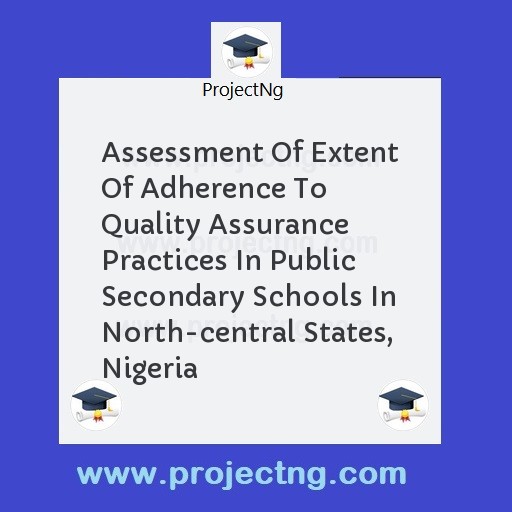Assessment Of Extent Of Adherence To Quality Assurance Practices In Public Secondary Schools In North-central States, Nigeria
Education Project Topics
Get the Complete Project Materials Now! »
ASSESSMENT OF EXTENT OF ADHERENCE TO QUALITY
ASSURANCE PRACTICES IN PUBLIC SECONDARY SCHOOLS IN
NORTH-CENTRAL STATES, NIGERIA
Abstract
The study was carried out to access quality assurance practices in secondary schools in North
Central States of Nigeria. Specifically, six purposes, six research questions and six null
hypotheses guided the study. Descriptive survey design was used to carry out the study. The
study was carried out in North-Central States, Nigeria. North-Central States, Nigeria consists of
six states, namely Benue, Kogi, Kwara, Nassarawa, Niger and Plateau states. The population of
the study was 2304 principals and evaluators. A sample of 1200 respondents (931 principals and
267 school evaluators) were selected; stratified random sampling technique was used to generate
the required sample. The instrument for collecting the required data for the study was a
structured questionnaire which was personally developed by the researcher through the review of
relevant literature. In order to ascertain the validity of the instrument, its initial draft was face
validated by three experts, two in Educational Administration and Planning and one in
Measurement and Evaluation, all from the University of Nigeria, Nsukka. The experts were
requested to examine the instrument in terms of the relevance of the contents and clarity of the
statements in relation to the research questions and specific purposes of the study. The reliability
of the instrument was ascertained by trial testing it on 20 subjects in Enugu States. Cronbach’s
Alpha method of reliability estimate was used to determine the internal consistency of the items
which were generated from Cluster A – F; 0.77, 0.67, 0.76, 0.92, 0.93, 0.91 respectively. Direct
Delivery and Retrieval Technique (DDRT) was used by the researcher and six research assistants
helped to collect the required data for the study. The data collected from the respondents were
analyzed with descriptive and inferential statistics. The descriptive statistics which involve the
use of mean scores and standard deviation were used to answer the research questions. The t-test
statistics was used to test the corresponding null hypotheses at 0.05 level of significance. The
findings of the study showed that the secondary schools in North-Central States, Nigeria adhere
to the FIS guidelines on provision of infrastructural facilities in post primary schools to a low
extent. It was also found that the secondary schools in North-Central States, Nigeria adhere to
the FIS guidelines on provision of relevant curriculum, provision of effective teaching, effective
school management, provision of learners’ welfare needs and maintenance of effective schoolcommunity
relationship in secondary schools to a high extent. The principals and evaluators
differed significantly in their opinion on the extent to which secondary schools in North-Central
States, Nigeria adhere to the FIS guidelines on provision of infrastructural facilities and on
provision of relevant curriculum in secondary schools. It was recommended among others that
the Federal Inspectorate Service should monitor effectively the compliance of secondary schools
to its guidelines on quality assurance practices. This will guide the educational policy-makers in
formulating relevant policies aimed at improving quality assurance practices in post primary
schools for the effective and efficient delivery of quality education in secondary schools.
2
CHAPTER ONE
INTRODUCTION
Background of the study
Secondary schools occupy a strategic position in every educational system since
they provide a vital link between primary and tertiary institutions. According to the
Federal Republic of Nigeria (2004), secondary schools are where children receive
education after primary education and before entering into tertiary level of education.
Lippit (2007) conceptualized secondary schools as educational institutions designed
for the provision of full-time education to students who are within the age range of 11
to 18. According to Eubanks and Eubanks (2000), the average age of entrance into the
secondary school is 10–11 year and expected year of graduation is 17–19 years. In this
study, secondary schools are considered as educational institutions which aim at
inculcating worthwhile knowledge, skills, attitudes, competencies and values to
students. The broad goal of secondary school education in Nigeria is to prepare the
individual for useful living within the society and for transition into tertiary education.
To ensure that the role of education of its different levels are realized, it is necessary to
engage in regular assessment of educational processes and practices
Assessment is the process of measuring the level of performance of an
individual or an organization in a particular area or field of endeavour (Edikpa, 2008).
This definition as it relates to this study, implies that assessment involves measuring
the level of performance of secondary schools in the implementation of quality
assurance practices. According to Mistra (2006), assessment is the action of
evaluating, appraising, estimating, and/or calculating the value or worth of an event,
activities or programme. Paulk (2011) conceptualized it as any activity that involve
1
2
the use of empirical data to refine programmes and improve their performance. Thus,
assessment is operationally defined in this study as the process of determining the
extent to which secondary schools carry out their quality assurance practices in
conformity with the established guidelines for their implementation.
Quality is a term that is used to show that the programme, activity
Be the First to Share On Social

Enjoying our content?
Don't miss out on new videos! Subscribe to our YouTube channel for more awesome content.
Subscribe Now!













